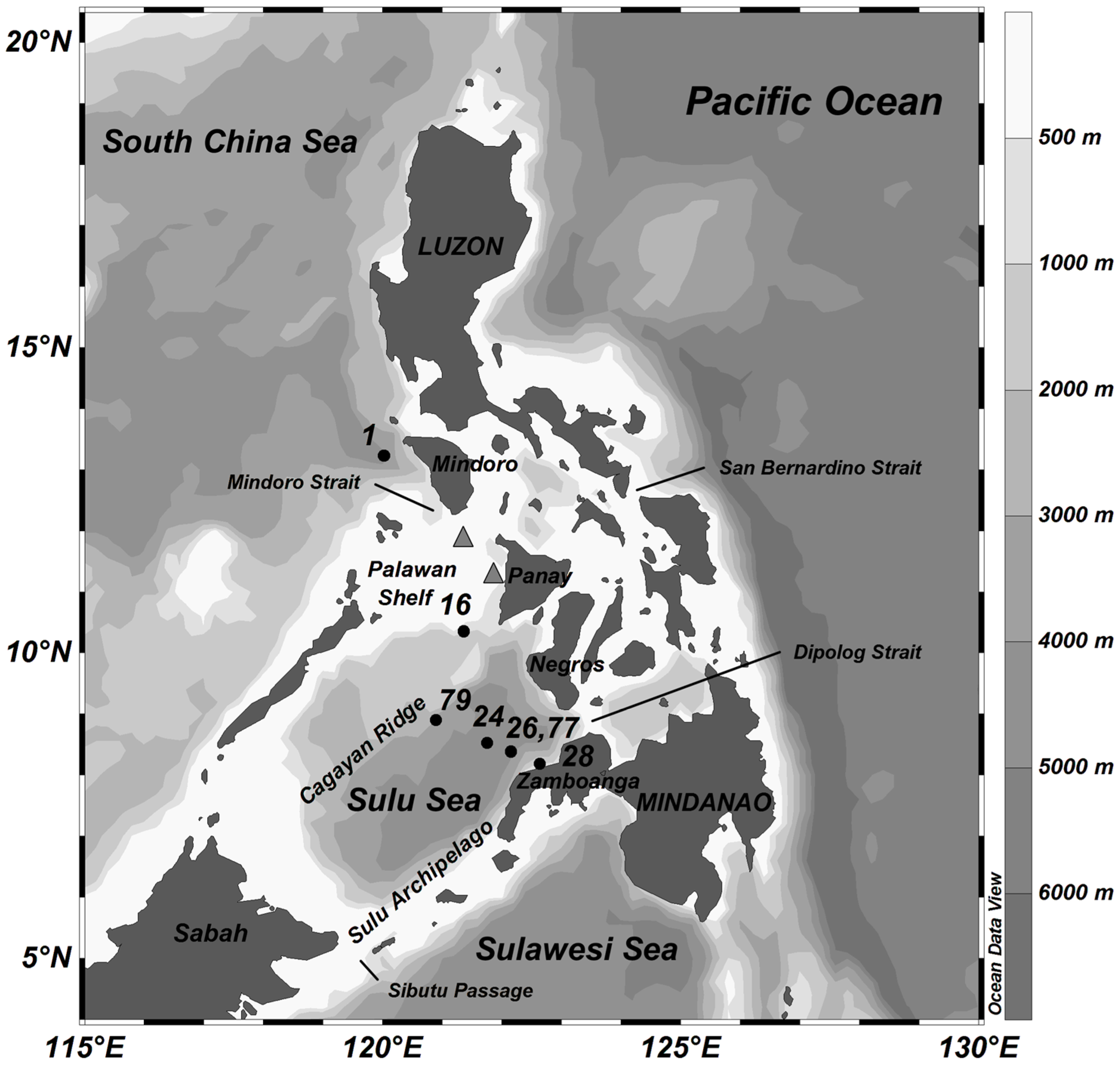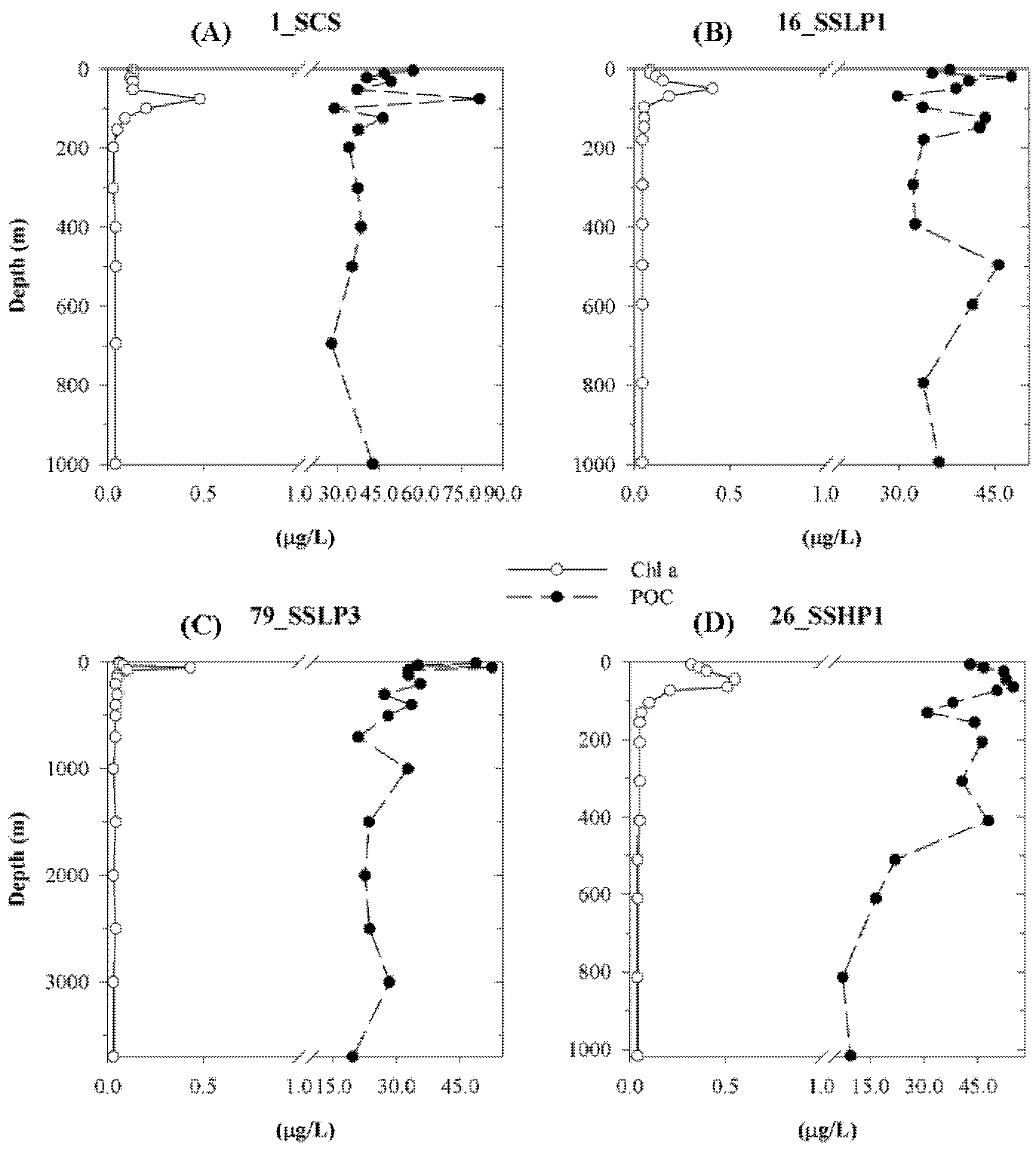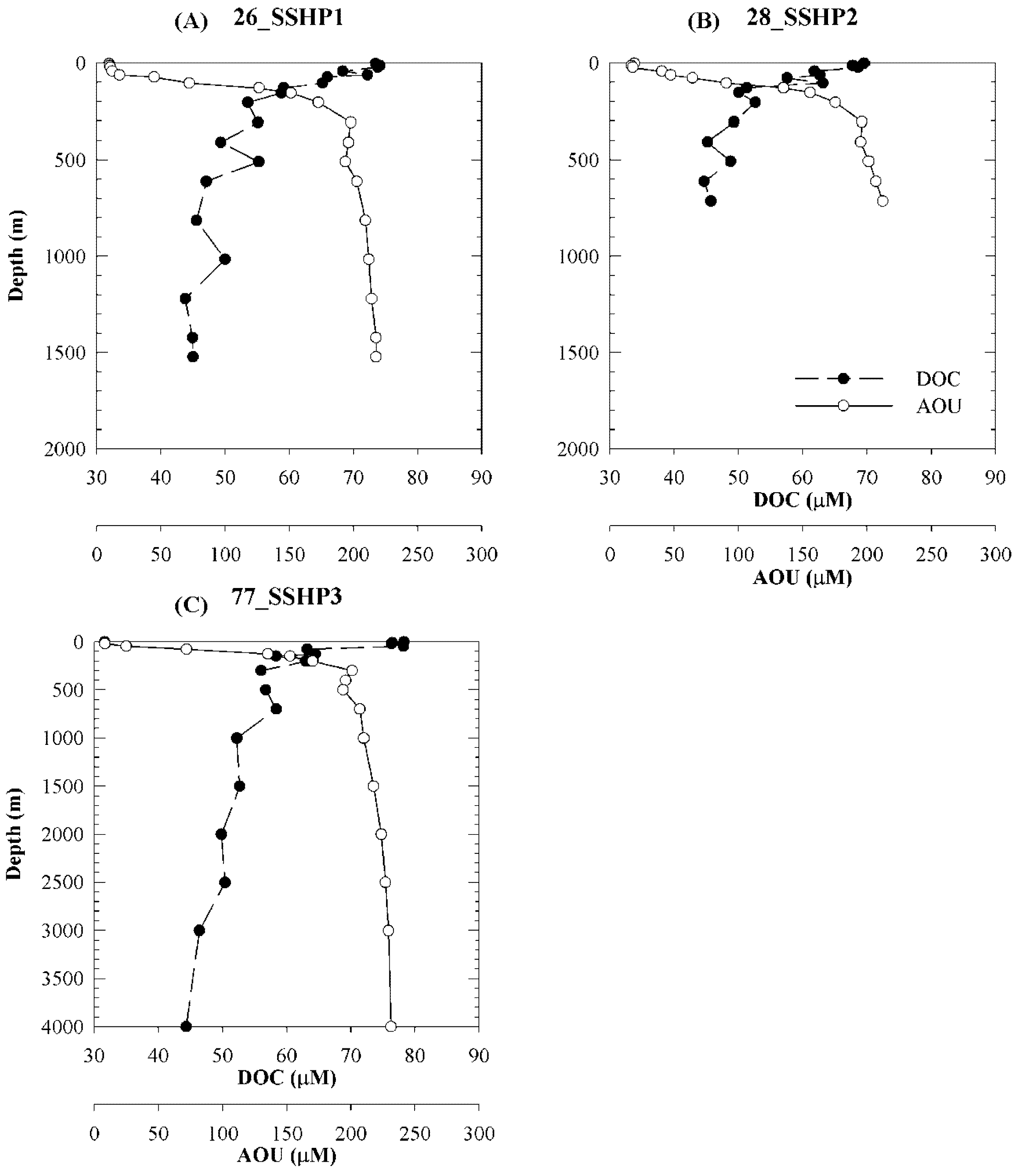Organic Carbon Concentrations in High- and Low-Productivity Areas of the Sulu Sea
Abstract
:1. Introduction
2. Materials and Methods
2.1. Water Sampling
2.2. Laboratory Analyses
3. Results and Discussion
3.1. General Distribution and Surface POC and DOC Concentrations
3.2. Organic Carbon Dynamics across the Mindoro and Panay Straits
3.3. Organic Carbon Distributions at the Zamboanga Upwelling Region
3.4. Organic Carbon at Depths
3.4.1. POC
3.4.2. DOC
3.5. Organic Carbon and the Sustainable Use of the Environment and Resources
4. Conclusions
Supplementary Materials
Author Contributions
Acknowledgments
Conflicts of Interest
References
- Chester, R. Marine Geochemistry, 2nd ed.; Blackwell Science Ltd.: Malden, MA, USA, 2003; ISBN 1-4051-0172-5. [Google Scholar]
- Ogawa, H.; Tanoue, E. Dissolved organic matter in oceanic waters. J. Oceanogr. 2003, 59, 129–147. [Google Scholar] [CrossRef]
- Hansell, D.A.; Carlson, C.A.; Repeta, D.J.; Schlitzer, R. Dissolved organic matter in the ocean: A controversy stimulates new insights. Oceanography 2009, 22, 202–211. [Google Scholar] [CrossRef]
- Nagata, T.; Tamburini, C.; Aristegui, J.; Baltar, F.; Bochdansky, A.B.; Fonda-Umani, S.; Fukuda, H.; Gogou, A.; Hansell, D.A.; Hansman, R.L.; et al. Emerging concepts on microbial processes in the bathypelagic ocean—Ecology, biogeochemistry, and genomics. Deep-Sea Res. Part II 2010, 57, 1519–1536. [Google Scholar] [CrossRef]
- Bishop, J.K.B. Transmissometer measurement of POC. Deep Sea Res. Part I 1999, 46, 353–369. [Google Scholar] [CrossRef]
- Behrenfeld, M.J.; Boss, E. Beam attenuation and chlorophyll concentration as alternative optical indices of phytoplankton biomass. J. Mar. Res. 2006, 64, 431–451. [Google Scholar] [CrossRef]
- Hansell, D.A.; Carlson, C.A. Deep-ocean gradients in the concentration of dissolved organic carbon. Nature 1998, 395, 263–266. [Google Scholar] [CrossRef]
- Carlson, C.A.; Hansell, D.A.; Nelson, N.B.; Siegel, D.A.; Smethie, W.M.; Khatiwala, S.; Meyers, M.M.; Halewood, E. Dissolved organic carbon export and subsequent remineralization in the mesopelagic and bathypelagic realms of the North Atlantic basin. Deep-Sea Res. Part II 2010, 57, 1433–1445. [Google Scholar] [CrossRef]
- Murray, J.W.; Barber, R.T.; Roman, M.R.; Bacon, M.P.; Feely, R.A. Physical and biological controls on carbon cycling in the Equatorial Pacific. Science 1994, 266, 58–65. [Google Scholar] [CrossRef] [PubMed]
- Hansell, D.A.; Carlson, C.A.; Bates, N.R.; Poisson, A. Horizontal and vertical removal of organic carbon in the equatorial Pacific Ocean: A mass balance assessment. Deep-Sea Res. Part II 1997, 44, 2115–2130. [Google Scholar] [CrossRef]
- Stoll, M.H.C.; Van Aken, H.M.; De Baar, H.J.W.; De Boer, C.J. Meridional carbon dioxide transport in the northern North Atlantic. Mar. Chem. 1996, 55, 205–216. [Google Scholar] [CrossRef] [Green Version]
- Liu, K.-K.; Lai, Z.-L.; Gong, G.-C.; Shiah, F.-K. Distribution of particulate organic matter in the Southern East China Sea: Implications in production and transport. Terr. Atmos. Ocean. Sci. 1995, 6, 27–45. [Google Scholar] [CrossRef]
- Chen, C.T.A.; Wang, S.L. Carbon, alkalinity and nutrient budgets on the East China Sea continental shelf. J. Geophys. Res. 1999, 104, 20675–20686. [Google Scholar] [CrossRef] [Green Version]
- Hung, J.-J.; Lin, P.-L.; Liu, K.-K. Dissolved and particulate organic carbon in the southern East China Sea. Cont. Shelf Res. 2000, 20, 545–569. [Google Scholar] [CrossRef]
- Hung, J.-J.; Chen, C.-H.; Gong, G.-C.; Sheu, D.-D.; Shiah, F.-K. Distributions, stoichiometric patterns and cross-shelf exports of dissolved organic matter in the East China Sea. Deep-Sea Res. Part II 2003, 50, 1127–1145. [Google Scholar] [CrossRef]
- U.S. Eastern Continental Shelf Team. Eastern US Continental Shelf Carbon Budget: Integrating Models, Data Assimilation and Analysis. Oceanography 2008, 21, 86–104. [Google Scholar] [CrossRef]
- Chen, C.T.A. Microbial carbon pump: Additional considerations. Nat. Rev. Microbiol. 2011, 9, 555. [Google Scholar] [CrossRef] [PubMed]
- Jiao, N.; Herndl, G.J.; Hansell, D.A.; Benner, R.; Kattner, G.; Wilhelm, S.W.; Kirchman, D.L.; Weinbauer, M.G.; Luo, T.; Chen, F.; et al. Microbial production of recalcitrant dissolved organic matter: The long-term carbon storage in the global ocean. Nat. Rev. Microbiol. 2010, 8, 593–599. [Google Scholar] [CrossRef] [PubMed]
- Hofmann, M.; Schellnhuber, H.J. Oceanic acidification affects marine carbon pump and triggers extended marine oxygen holes. Proc. Natl. Acad. Sci. USA 2009, 106, 3017–3022. [Google Scholar] [CrossRef] [PubMed] [Green Version]
- Engel, A.; Barcelos e Ramos, J.; Geider, R.; Hutchins, D.A.; Lee, C.; Rost, B.; Rottgers, R.; Thingstad, F. Production and export of organic matter. In Guide to Best Practices for Ocean Acidification Research and Data Reporting; Riebesell, U., Fabry, V.J., Hansson, L., Gattuso, J.-P., Eds.; European Commission: Luxembourg, 2011; ISBN 978-92-79-20650-4. [Google Scholar]
- Exon, N.F.; Haake, F.-W.; Hartman, M.; Kogler, F.-C.; Muller, P.J.; Whiticar, M.J. Morphology, water characteristics and sedimentation in the silled Sulu Sea, Southeast Asia. Mar. Geol. 1981, 39, 165–195. [Google Scholar] [CrossRef]
- Linsley, B.K.; Thunell, R.C.; Morgan, C.; Williams, D.F. Oxygen minimum expansion in the Sulu Sea, Western Equatorial Pacific, during the last glacial low stand of sea level. Mar. Micropaleontol. 1985, 9, 395–418. [Google Scholar] [CrossRef]
- Bertrand, P.; Berner, U.; Lallier-Verges, E. Organic sedimentation in Celebes and Sulu Basins: Type of organic matter and evaluation of organic carbon accumulation rates. In Proceedings of the Ocean Drilling Program, Scientific Results; Silver, E.A., Rangin, C., von Breymann, M.T., Berner, U., Bertrand, P., Betzler, C., Brass, G.W., Hsu, V., Huang, Z., Jarrard, R.D., et al., Eds.; Ocean Drilling Program: College Station, TX, USA, 1991; Volume 124, pp. 217–225. [Google Scholar]
- Sheu, D.D.D. Geochemical and stable isotopic studies of Celebes and Sulu Sea sediments: Sites 767 and 768, ODP Leg 124. Terr. Atmos. Ocean. Sci. 1991, 2, 267–279. [Google Scholar] [CrossRef]
- Calvert, S.E.; Pedersen, T.F.; Thunell, R.C. Geochemistry of the surface sediments of the Sulu and South China Seas. Mar. Geol. 1993, 114, 207–231. [Google Scholar] [CrossRef]
- Kuehl, S.A.; Fuglseth, T.J.; Thunell, R.C. Sediment mixing and accumulation rates in the Sulu and South China Seas: Implications for organic carbon preservation in deep-sea environments. Mar. Geol. 1993, 111, 15–35. [Google Scholar] [CrossRef]
- Philippine Energy Contracting Rounds Technical Report. Petroleum Potential of West Palawan Basins and Sulu Sea Region. Available online: http://www.ccop.or.th/epf/philippines/other_pdf/TechnicalReport.pdf (accessed on 19 January 2018).
- Ichikawa, T. Particulate organic carbon and nitrogen in the adjacent seas of the Pacific Ocean. Mar. Biol. 1982, 68, 49–60. [Google Scholar] [CrossRef]
- Yoshida, A.; Nishimura, M.; Kogure, K. Bacterial community structure in the Sulu Sea and adjacent areas. Deep-Sea Res. Part II 2007, 54, 103–113. [Google Scholar] [CrossRef]
- Ferrera, C.M.; Jacinto, G.S.; Chen, C.-T.A.; San Diego-McGlone, M.L.; Datoc, M.F.K.T.; Lagumen, M.C.T.; Senal, M.I.S. Carbonate parameters in high and low productivity areas of the Sulu Sea, Philippines. Mar. Chem. 2017, 195, 2–14. [Google Scholar] [CrossRef]
- Department of Energy. Handbook of Methods for the Analysis of the Various Parameters of the Carbon Dioxide System in Sea Water (Ver. 2, ORNL/CDIAC-74); Dickson, A.G., Goyet, C., Eds.; Oak Ridge National Lab.: Oak Ridge, TN, USA, 1994. [Google Scholar]
- Knap, A.; Michaels, A.; Close, A.; Ducklow, H.; Dickson, A. Protocols for the Joint Global Ocean Flux Studies (JGOFS) Core Measurements (JGOFS Report No. 19); UNESCO: Paris, France, 1994. [Google Scholar]
- Chen, C.T.A.; Hou, W.P.; Gamo, T.; Wang, S.L. Carbonate-related parameters of the subsurface waters in the West Philippine, South China and Sulu Seas. Mar. Chem. 2006, 99, 151–161. [Google Scholar] [CrossRef]
- Gamo, T.; Kato, Y.; Hasumoto, H.; Kakiuchi, H.; Momoshima, N.; Takahata, N.; Sano, Y. Geochemical implications for the mechanism of deep convection in a semi-closed tropical marginal basin: Sulu Sea. Deep-Sea Res. Part II 2007, 54, 4–13. [Google Scholar] [CrossRef]
- Gordon, A.L.; Tessler, Z.D.; Villanoy, C. Dual overflows into the deep Sulu Sea. Geophys. Res. Lett. 2011, 38, L18606. [Google Scholar] [CrossRef]
- Gordon, A.L.; Sprintall, J.; Ffield, A. Regional oceanography of the Philippine archipelago. Oceanography 2011, 24, 14–27. [Google Scholar] [CrossRef]
- Tessler, Z.D.; Gordon, A.L.; Pratt, L.J.; Sprintall, J. Transport and dynamics of the Panay Sill overflow in the Philippine seas. J. Phys. Oceanogr. 2010, 40, 2679–2695. [Google Scholar] [CrossRef]
- Hung, J.-J.; Wang, S.-M.; Chen, Y.-L. Biogeochemical controls on distributions and fluxes of dissolved and particulate organic carbon in the Northern South China Sea. Deep-Sea Res. Part II 2007, 54, 1486–1503. [Google Scholar] [CrossRef]
- Liu, Q.; Pan, D.L.; Bai, Y.; Wu, K.; Chen, C.T.A.; Liu, Z.L.; Zhang, L. Estimating dissolved organic carbon inventories in the East China Sea using remote sensing data. J. Geophys. Res. Oceans 2014, 119, 6557–6574. [Google Scholar] [CrossRef]
- Yang, L.; Chen, C.-T.A.; Lui, H.-K.; Zhuang, W.-E. Effects of microbial transformation on dissolved organic matter in the east Taiwan Strait and implications for carbon and nutrient cycling. Estuar. Coast. Shelf Sci. 2016, 180, 59–68. [Google Scholar] [CrossRef]
- Hurlburt, H.E.; Metzger, E.J.; Sprintall, J.; Riedlinger, S.N.; Arnone, R.A.; Shinoda, T.; Xu, X. Circulation in the Philippine archipelago simulated by 1/12° and 1/25° global HYCOM and EAS NCOM. Oceanography 2011, 24, 28–47. [Google Scholar] [CrossRef]
- Chen, C.T.A. Oxygen solubility in seawater. In Oxygen and Ozone: Solubility Data Series; Battino, R., Ed.; Pergamon Press: Oxford, UK, 1981; Volume 7, pp. 41–55. ISBN 978-0-08-023915-6. [Google Scholar]
- Girton, J.B.; Chinn, B.S.; Alford, M.H. Internal wave climates of the Philippine seas. Oceanography 2011, 24, 100–111. [Google Scholar] [CrossRef]
- Zhu, Z.Y.; Zhang, J.; Wu, Y.; Lin, J. Bulk particulate organic carbon in the East China Sea: Tidal influence and bottom transport. Prog. Oceanogr. 2006, 69, 37–60. [Google Scholar] [CrossRef]
- Rochelle-Newall, E.J.; Fisher, T.R.; Fan, C.; Glibert, P.M. Dynamics of chromophoric dissolved organic matter and dissolved organic carbon in experimental mesocosms. Int. J. Remote Sens. 1999, 20, 627–641. [Google Scholar] [CrossRef] [Green Version]
- Boss, E.; Pegau, W.S.; Zaneveld, J.R.V.; Barnard, A.H. Spatial and temporal variability of absorption by dissolved material at a continental shelf. J. Geophys. Res. 2001, 106, 9499–9507. [Google Scholar] [CrossRef] [Green Version]
- Quadfasel, D.; Kudrass, H.; Frische, A. Deep water renewal by turbidity currents in the Sulu Sea. Nature 1990, 348, 320–322. [Google Scholar] [CrossRef]
- Kondo, Y.; Takeda, S.; Furuya, K. Distribution and speciation of dissolved iron in the Sulu Sea and its adjacent waters. Deep-Sea Res. Part II 2007, 54, 60–80. [Google Scholar] [CrossRef]
- Norisuye, K.; Ezoe, M.; Nakatsuka, S.; Umetani, S.; Sohrin, Y. Distribution of bioactive trace metals (Fe, Co, Ni, Cu, Zn and Cd) in the Sulu Sea and its adjacent seas. Deep-Sea Res. Part II 2007, 54, 14–37. [Google Scholar] [CrossRef]
- Obata, H.; Doi, T.; Hongo, Y.; Alibo, D.S.; Minami, H.; Kato, Y.; Maruo, M. Manganese, cerium and iron in the Sulu, Celebes and Philippine Seas. Deep-Sea Res. Part II 2007, 54, 38–49. [Google Scholar] [CrossRef]
- Jones, B.H.; Lee, C.M.; Toro-Farmer, G.; Boss, E.S.; Gregg, M.C.; Villanoy, C.L. Tidally driven exchange in an archipelago strait: Biological and optical responses. Oceanography 2011, 24, 142–155. [Google Scholar] [CrossRef]
- Gordon, A.L.; Yanagi, T. Water masses and circulation of Southeast Asian seas. In Critical States: Environmental Challenges to Development in Monsoon Southeast Asia; Lebel, L., Snidvongs, A., Chen, C.-T.A., Daniel, R., Eds.; Strategic Information and Research Development Centre: Kuala Lumpur, Malaysia, 2009; ISBN 978-983-3782-62-8. [Google Scholar]
- Villanoy, C.L.; Cabrera, O.C.; Yniguez, A.; Camoying, M.; De Guzman, A.; David, L.T.; Flament, P. Monsoon-driven coastal upwelling off Zamboanga Peninsula, Philippines. Oceanography 2011, 24, 156–165. [Google Scholar] [CrossRef]
- Sharp, J.H.; Benner, R.; Bennett, L.; Carlson, C.A.; Fitzwater, S.E.; Peltzer, E.T.; Tupas, L.M. Analyses of dissolved organic carbon in seawater: The JGOFS EqPac methods comparison. Mar. Chem. 1995, 48, 91–108. [Google Scholar] [CrossRef]
- Wang, J.; Qi, Y.; Jones, I.S.F. An analysis of the characteristics of chlorophyll in the Sulu Sea. J. Mar. Syst. 2006, 59, 111–119. [Google Scholar] [CrossRef] [Green Version]
- Gardner, W.D.; Richardson, M.J.; Carlson, C.A.; Hansell, D.; Mishonov, A.V. Determining true particulate organic carbon: Bottles, pumps and methodologies. Deep-Sea Res. Part II 2003, 50, 655–674. [Google Scholar] [CrossRef]
- Lermusiaux, P.F.J.; Haley, P.J., Jr.; Leslie, W.G.; Agarwal, A.; Lohutov, O.G.; Burton, L.J. Multiscale physical and biological dynamics in the Philippine archipelago: Predictions and processes. Oceanography 2011, 24, 70–89. [Google Scholar] [CrossRef]
- Okubo, A.; Obata, H.; Gamo, T.; Minami, H.; Yamada, M. Scavenging of 230Th in the Sulu Sea. Deep-Sea Res. Part II 2007, 54, 50–59. [Google Scholar] [CrossRef]
- Aminot, A.; Kerouel, R. Dissolved organic carbon, nitrogen and phosphorus in the N–E Atlantic and the N–W Mediterranean with particular reference to non-refractory fractions and degradation. Deep-Sea Res. Part I 2004, 51, 1975–1999. [Google Scholar] [CrossRef]
- Aristegui, J.; Duarte, C.M.; Agusti, S.; Doval, M.; Alvarez-Salgado, X.A.; Hansell, D.A. Dissolved organic carbon support of respiration in the dark ocean. Science 2002, 298, 1967. [Google Scholar] [CrossRef] [PubMed] [Green Version]
- Hansell, D.A.; Carlson, C.A. Biogeochemistry of total organic carbon and nitrogen in the Sargasso Sea: Control by convective overturn. Deep-Sea Res. Part II 2001, 48, 1649–1667. [Google Scholar] [CrossRef]
- Santinelli, C.; Nannicini, L.; Seritti, A. DOC dynamics in the meso and bathypelagic layers of the Mediterranean Sea. Deep-Sea Res. Part II 2010, 57, 1446–1459. [Google Scholar] [CrossRef]
- Dai, M.; Meng, F.; Tang, T.; Kao, S.J.; Lin, J.; Chen, J.; Huang, J.C.; Tian, J.; Gan, J.; Yang, S. Excess total organic carbon in the intermediate water of the South China Sea and its export to the North Pacific. Geochem. Geophys. Geosyst. 2009, 10, Q12002. [Google Scholar] [CrossRef]
- Qu, B.; Song, J.; Yuan, H.; Li, X.; Li, N. Carbon Chemistry in the Mainstream of Kuroshio Current in Eastern Taiwan and Its Transport of Carbon into the East China Sea Shelf. Sustainability 2018, 10, 791. [Google Scholar] [CrossRef]
- Basu, S.; Mackey, K.R.M. Phytoplankton as Key Mediators of the Biological Carbon Pump: Their Responses to a Changing Climate. Sustainability 2018, 10, 869. [Google Scholar] [CrossRef]
- Lui, H.-K.; Chen, K.-Y.; Chen, C.-T.A.; Wang, B.-S.; Lin, H.-L.; Ho, S.-H.; Tseng, C.-J.; Yang, Y.; Chan, J.-W. Physical Forcing-Driven Productivity and Sediment Flux to the Deep Basin of Northern South China Sea: A Decadal Time Series Study. Sustainability 2018, 10, 971. [Google Scholar] [CrossRef]
- Zheng, H.; Yan, Z.; Chen, J.; Jin, H.; Chen, C.-T.A.; Liu, M.; Yan, Z.; Ji, Z. Seasonal Variations of Dissolved Organic Matter in the East China Sea Using EEM-PARAFAC and Implications for Carbon and Nutrient Cycling. Sustainability 2018, 10, 1444. [Google Scholar] [CrossRef]
- GIOVANNI: The Bridge between Data and Science v 4.25. Available online: https://giovanni.gsfc.nasa.gov/giovanni/ (accessed on 10 May 2018).
- Romera-Castillo, C.; Pinto, M.; Langer, T.M.; Álvarez-Salgado, X.A.; Herndl, G.J. Dissolved organic carbon leaching from plastics stimulates microbial activity in the ocean. Nat. Commun. 2018, 9, 1430. [Google Scholar] [CrossRef] [PubMed] [Green Version]
- Abreo, N.A.S.; Macusi, E.D.; Cuenca, G.C.; Ranara, C.T.B.; Andam, M.B.; Cardona, L.C.; Arabejo, G.F.P. Nutrient Enrichment, Sedimentation, Heavy Metals and Plastic Pollution in the Marine Environment and its Implications on Philippine Marine Biodiversity: A Review. IAMURE Int. J. Ecol. Conserv. 2015, 15. [Google Scholar] [CrossRef]










| Station | Depth Layer | Slope | y-Intercept | r2 (p Value) | n |
|---|---|---|---|---|---|
| South China Sea | |||||
| 1 | below MLD–200 m | −0.158 | 74.9 | 0.73 (0.065) | 5 |
| 300–1000 m | −0.100 | 67.6 | 0.26 (0.380) | 5 | |
| 1300–2000 m | −4.018 | 777 | 1.00 (0.032 *) | 3 | |
| Sulu Sea, Low Productivity | |||||
| 16 | below MLD–200 m | −0.144 | 66.1 | 0.97 (0.002 *) | 5 |
| 300–1000 m | 0.059 | 40.3 | 0.01 (0.878) | 6 | |
| 24 | below MLD–200 m | −0.118 | 64.6 | 0.63 (0.060) | 6 |
| 300–1000 m | −0.087 | 57.1 | 0.03 (0.750) | 6 | |
| 79 | below MLD–200 m | −0.030 | 53.4 | 0.06 (0.839) | 3 |
| 300–1000 m | 0.032 | 44.5 | 0.00 (0.934) | 5 | |
| 1500–3700 m | −0.578 | 146 | 0.72 (0.070) | 5 | |
| Sulu Sea, High Productivity | |||||
| 26 | below MLD–200 m | −0.120 | 70.9 | 0.93 (0.008 *) | 5 |
| 300–1000 m | −0.454 | 121 | 0.41 (0.173) | 6 | |
| 28 | below MLD–200 m | −0.121 | 66.6 | 0.69 (0.040 *) | 6 |
| 300–700 m | −0.168 | 72.9 | 0.17 (0.486) | 5 | |
| 77 | below MLD–200 m | −0.130 | 76.5 | 0.65 (0.098) | 5 |
| 300–1000 m | −0.207 | 88.0 | 0.19 (0.564) | 4 | |
| 1500–4000 m | −0.739 | 177 | 0.83 (0.032 *) | 5 | |
© 2018 by the authors. Licensee MDPI, Basel, Switzerland. This article is an open access article distributed under the terms and conditions of the Creative Commons Attribution (CC BY) license (http://creativecommons.org/licenses/by/4.0/).
Share and Cite
Ferrera, C.M.; Jacinto, G.S.; Chen, C.-T.A.; Lui, H.-K. Organic Carbon Concentrations in High- and Low-Productivity Areas of the Sulu Sea. Sustainability 2018, 10, 1867. https://doi.org/10.3390/su10061867
Ferrera CM, Jacinto GS, Chen C-TA, Lui H-K. Organic Carbon Concentrations in High- and Low-Productivity Areas of the Sulu Sea. Sustainability. 2018; 10(6):1867. https://doi.org/10.3390/su10061867
Chicago/Turabian StyleFerrera, Charissa M., Gil S. Jacinto, Chen-Tung Arthur Chen, and Hon-Kit Lui. 2018. "Organic Carbon Concentrations in High- and Low-Productivity Areas of the Sulu Sea" Sustainability 10, no. 6: 1867. https://doi.org/10.3390/su10061867
APA StyleFerrera, C. M., Jacinto, G. S., Chen, C.-T. A., & Lui, H.-K. (2018). Organic Carbon Concentrations in High- and Low-Productivity Areas of the Sulu Sea. Sustainability, 10(6), 1867. https://doi.org/10.3390/su10061867






